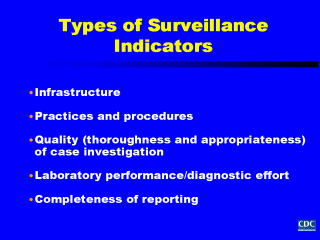At
present, there are five types of surveillance performance indicators: those looking at the
infrastructure of a surveillance system, those examining practices and procedures, those
concerned with the quality of case investigations, and with laboratory performance and
diagnostic effort, and finally ones which assess the completeness of reporting.
The examples of the specific surveillance performance indicators which follow deal with
vaccine-preventable diseases, especially regarding surveillance for measles, and for Acute
Flaccid Paralysis (AFP) to detect cases of paralytic poliomyelitis. This class of diseases
were selected because it is the one in which surveillance performance indicators have been
most extensively developed. Nonetheless, many of the indicators can also be applied to
assessing the performance of surveillance systems focused on environmental and
occupational exposures, chronic diseases, injuries, and health promotion and disease
prevention behaviors.
